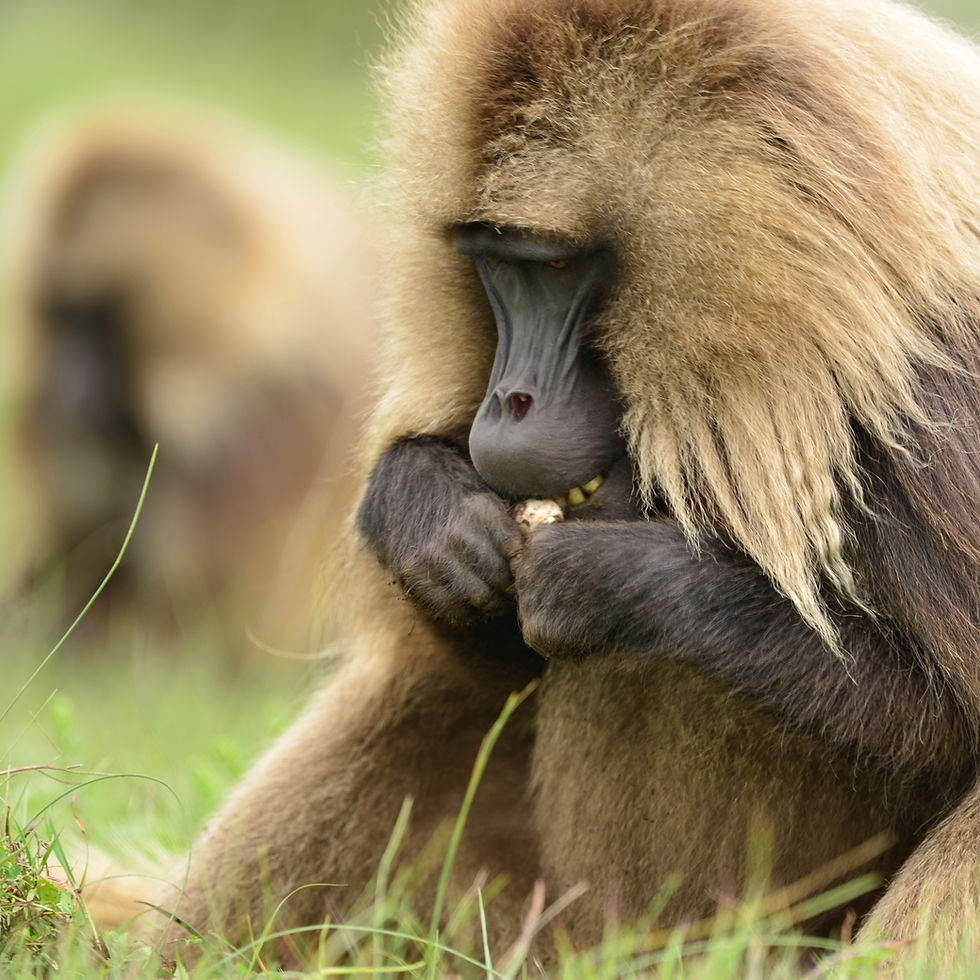ETHIOPIA / Part I: Food Poisoning, Gelada Monkeys and Interesting Ravens...
- Connie M Van Cleve

- Sep 8, 2018
- 4 min read

I went to Ethiopia for three-weeks in the summer of 2018 with several definitive goals in mind. The first goal was to go to the Simien Mountains to see the endemic Gelada Monkeys.

The second goal was to visit the city of Harar to meet the Hyena man and all his gorgeous, furry friends.

The Karo People
The third goal was to travel south to the Omo Valley to meet the colorful tribal people who call this far-flung region home. All of my goals were happily met, and all exceeded my expectations. Ethiopia was absolutely spectacular, but it also came with its fair share of challenges.
I landed in the capitol of Addis Ababa on the 6th of August, after spending three weeks guiding a nine-person camping safari of my own through South Africa and Namibia. I was exhausted (because guiding is hard work!) and ready for some downtime - so what did I do? Did I take a rest? No. I immediately contacted a guide to show me around the infamous Merkato in Addis. It was a massive, chaotic and ramshackle African market; we saw as much as I could tolerate in three hours and I was starving, so my guide took me to a restaurant to try the local delicacy - Kitfo - or Ethiopian Steak Tartar.
Oh, my. Will I ever learn? Adventurous to a fault, I grabbed some spongy injera bread and dug right into this RAW repast of minced Ox meat mixed with clarified butter and spices, accompanied by spinach and this funny white stuff called false-banana that tasted more like aged cheese. It was all very delicious. The 'raw' thing didn't bother me at all, because I like my steaks rare and I love sushi, but it really should have, because I was new to Ethiopia and my digestive tract was unprepared for what I can only assume was a microbial, pathogenic onslaught.

And, yes...so very sick, I got. Four whole days lost to bad decision-making. I spent the two remaining days in Addis in bed (near the toilet), and two more days resting in Gonder on antibiotics. I was supposed to camp on that fourth night in the Simiens, but I didn't trust my health situation, so I did a day-trip on the fifth day instead. And what a trip it was!

I got to spend an hour mingling with a troop of over 200 Geladas (Theropithecus gelada) - or Bleeding Heart Monkeys. Geladas are found only in the grasslands of the central Ethiopian plateau. They live at high elevations (1,800–4,400 m or 5,900–14,400 ft), and use the cliffs for sleeping and the grasslands for foraging.

"Ooooh, this root is soooo delicious!"
Geladas are the only primates that are primarily graminivores and grazers – grass blades make up to 90% of their diet. They eat both the blades and the seeds of grasses. They eat flowers, rhizomes and roots when available, using their hands to dig for the latter two. They consume herbs, small plants, fruits, creepers, bushes and thistles. Insects can be eaten, but only rarely and only if they can easily be obtained. At night, they sleep on the ledges of cliffs. At sunrise, they leave the cliffs and travel to the tops of the plateau to feed and to socialize.

"Ewwww! Who farted?"

"Uh, mommy? What's that funny looking pinkish-white thing? And why is it staring at us?"

Example of the 'Bleeding Heart' patch of skin and the lack of red on the 'buttocks', due to the fact that this species spends its entire life sitting on its bottom, grazing.
Geladas are mistakenly called Baboons, though they're not true baboons at all. They don't get swollen 'red buttocks' during estrus that is characteristic to baboons. Instead, males, and more obviously females, display their estrus with the reddening and blistering of the hourglass patch of skin on their chest.

Apparently, he forgot to take out the trash.
Another interesting fact about this old world monkey, is that it's the only species, other than man, known to 'cheat'. While observing geladas during field studies, researchers discovered that the monkeys were capable of 'cheating' on their partners and covering up their 'infidelity'. A non-dominant male would mate surreptitiously with a female, suppressing their normal mating cries so as not to be overheard. If discovered, the dominant male would attack the miscreants in a clear form of punishment. It is the first time that evidence of the knowledge of cheating and fear of discovery has been recorded among animals in the wild. In fact, researchers believe that dishonesty and punishment are not uniquely human traits, and that the observed evidence of this behavior among gelada monkeys suggests that the roots of the human system of deceit, crime and punishment lie very deep indeed.

A husband chasing an adulterer, with the wife behind desperately trying to explain.
Besides seeing the Geladas, I also got to see a lot of other interesting critters and birds, including a much coveted species (I'm an avid birder!), the Thick-billed Raven (Corvus crassirostris). A corvid endemic to the Horn of Africa, it shares with the common raven the distinction of being the largest bird in the corvid family, and indeed the largest of the most diverse bird order with well over 5,000 identified species, the passerines. I was very lucky, because a lovely pair of these birds came and graciously modeled for me at Jinbar Falls!



To be continued...
























Comments